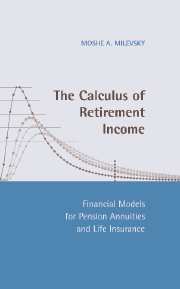Book contents
- Frontmatter
- Contents
- List of Figures and Tables
- I MODELS OF ACTUARIAL FINANCE
- 1 Introduction and Motivation
- 2 Modeling the Human Life Cycle
- 3 Models of Human Mortality
- 4 Valuation Models of Deterministic Interest
- 5 Models of Risky Financial Investments
- 6 Models of Pension Life Annuities
- 7 Models of Life Insurance
- 8 Models of DB vs. DC Pensions
- II WEALTH MANAGEMENT: APPLICATIONS AND IMPLICATIONS
- III ADVANCED TOPICS
- Bibliography
- Index
4 - Valuation Models of Deterministic Interest
from I - MODELS OF ACTUARIAL FINANCE
Published online by Cambridge University Press: 06 July 2010
- Frontmatter
- Contents
- List of Figures and Tables
- I MODELS OF ACTUARIAL FINANCE
- 1 Introduction and Motivation
- 2 Modeling the Human Life Cycle
- 3 Models of Human Mortality
- 4 Valuation Models of Deterministic Interest
- 5 Models of Risky Financial Investments
- 6 Models of Pension Life Annuities
- 7 Models of Life Insurance
- 8 Models of DB vs. DC Pensions
- II WEALTH MANAGEMENT: APPLICATIONS AND IMPLICATIONS
- III ADVANCED TOPICS
- Bibliography
- Index
Summary
Continuously Compounded Interest Rates?
Our models will mostly be developed in continuous time. This means that money grows as a result of the force of interest in a continuous manner. To maintain consistency, I will use the letter r to denote the current continuously compounded (CC) rate of interest. The relationship between the nominal CC rate r and the effective annual rate R = er – 1 is, via the exponential operator (or its inverse), the natural logarithm. For example, if the effective annual rate is 10% then the continuously compounded rate will be (a lower) ln[1 + 0.10] = 9.531% per annum. This 0.5% gap between the rates (47 basis points, to be exact) is substantial when compounded over long periods of time. Note that each basis point is one hundredth of a percentage point. Caution is therefore warranted when using a generic interest rate in any calculation or formula. Make sure you confirm the compounding period.
Tables 4.1 and 4.2 show the growth of one dollar under different compounding frequencies and effective annual rates. Of course, the more frequently we compound interest, the greater the sum of money available at the end of the year. Notice that a 12% rate compounded continuously yields a gain of 75 basis points (1.12750 vs. 1.12) over a 12% rate compounded annually.
- Type
- Chapter
- Information
- The Calculus of Retirement IncomeFinancial Models for Pension Annuities and Life Insurance, pp. 64 - 82Publisher: Cambridge University PressPrint publication year: 2006



